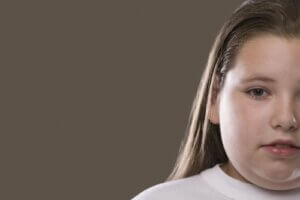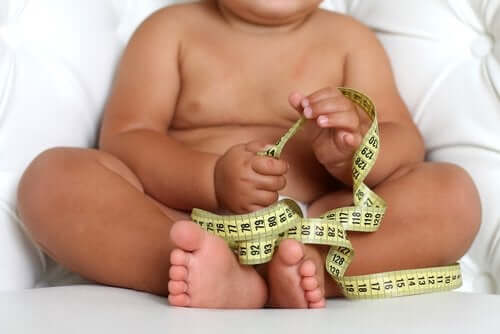Should You Put Your Child on a Diet?

Childhood obesity is a an important public health problem worldwide. According to the Aladino Study, in Spain the prevalence of child obesity is among the highest in Europe. Between 6 and 9 years old, 18.3% suffer from obesity and 24.6% are overweight, and these numbers are rising. However, we still wonder, can you put your child on a diet?
Is it advisable to put children on a diet?
In the case of adults, children and teenagers, obesity relates to other health risks, such as:
- Prediabetes.
- Type 2 diabetes.
- Hypertension.
- Asthma.
- Metabolic syndrome.
- Weakened immune system.
- Sleep disorders.

Additionally, overweight children have self-esteem issues and a lower quality of life. Obese children have an 80% chance to stay that way once they reach 35 years old. And, even though they might lose weight in the future, overweight or obese teenagers have a tendency to have a higher mortality risk by any cause, especially in the case of cardiovascular diseases.
Therefore, it’s urgent to detect this problem as soon as possible so children are healthy and have an adequate weight throughout their whole life. So, it’s necessary to visit a nutritionist to help the child lose the weight and follow a healthy diet.
How do we know if a child is overweight or obese?
When you suspect that your child is gaining weight, take them to the pediatrician or nutritionist to check their body composition. To assess the child’s physical state, it’s necessary to take a look at size, weight and body mass index (BMI).
Unlike adults, the World Health Organization (WHO) has set a specific percentiles of size, weight and BMI, according to age and sex. Thus, a child is overweight when above the 85th percentile.
How do we put a child on a diet?
First, it’s essential to understand the concept of a diet. It doesn’t refer to a strict diet in which you starve and eliminate food, but rather it consists of eating healthy food and reeducating the child and the family so that they learn to eat healthy.
Nutrition education
For a child to lose weight, the whole family must learn to eat healthy food. A very useful resource is the Harvard Healthy Eating Plate, which consists of vegetables and fruits in half of the plate, animal protein (meat, fish, eggs, dairy) or plant-based protein (legume) in a quarter of the plate, and whole grains or tubers (bread, pasta, rice, potato) in the rest of the plate.

On the other hand, it’s important to eliminate food with a high caloric density and a low nutritional density, such as pastries, breakfast cereals, juice, cookies, etc. This type of food could be left for special occasions or replaced by homemade sweets.
Portion reduction
Children shouldn’t follow a hypocaloric diet. They should adjust the amounts to their weight, sex and age, since they could be eating more than they should. Mothers don’t want their children to be hungry, but it’s important for them to recognize when they’re overeating.
At first, reducing portions or filling the plate with vegetables might be of help, since it contributes to feeling full.
Increasing physical activity
If the child doesn’t do exercise, we have to encourage them to move and play a sport. Nutrition isn’t enough; it’s the combination of nutrition and physical activity that will help them lose weight in a healthier and quicker way.
Therefore, if your child is overweight or obese, don’t hesitate to see a nutritionist to teach them how to eat and establish proper dietary habits, in order to prevent them from being an obese adult in the future.
Childhood obesity is a an important public health problem worldwide. According to the Aladino Study, in Spain the prevalence of child obesity is among the highest in Europe. Between 6 and 9 years old, 18.3% suffer from obesity and 24.6% are overweight, and these numbers are rising. However, we still wonder, can you put your child on a diet?
Is it advisable to put children on a diet?
In the case of adults, children and teenagers, obesity relates to other health risks, such as:
- Prediabetes.
- Type 2 diabetes.
- Hypertension.
- Asthma.
- Metabolic syndrome.
- Weakened immune system.
- Sleep disorders.

Additionally, overweight children have self-esteem issues and a lower quality of life. Obese children have an 80% chance to stay that way once they reach 35 years old. And, even though they might lose weight in the future, overweight or obese teenagers have a tendency to have a higher mortality risk by any cause, especially in the case of cardiovascular diseases.
Therefore, it’s urgent to detect this problem as soon as possible so children are healthy and have an adequate weight throughout their whole life. So, it’s necessary to visit a nutritionist to help the child lose the weight and follow a healthy diet.
How do we know if a child is overweight or obese?
When you suspect that your child is gaining weight, take them to the pediatrician or nutritionist to check their body composition. To assess the child’s physical state, it’s necessary to take a look at size, weight and body mass index (BMI).
Unlike adults, the World Health Organization (WHO) has set a specific percentiles of size, weight and BMI, according to age and sex. Thus, a child is overweight when above the 85th percentile.
How do we put a child on a diet?
First, it’s essential to understand the concept of a diet. It doesn’t refer to a strict diet in which you starve and eliminate food, but rather it consists of eating healthy food and reeducating the child and the family so that they learn to eat healthy.
Nutrition education
For a child to lose weight, the whole family must learn to eat healthy food. A very useful resource is the Harvard Healthy Eating Plate, which consists of vegetables and fruits in half of the plate, animal protein (meat, fish, eggs, dairy) or plant-based protein (legume) in a quarter of the plate, and whole grains or tubers (bread, pasta, rice, potato) in the rest of the plate.

On the other hand, it’s important to eliminate food with a high caloric density and a low nutritional density, such as pastries, breakfast cereals, juice, cookies, etc. This type of food could be left for special occasions or replaced by homemade sweets.
Portion reduction
Children shouldn’t follow a hypocaloric diet. They should adjust the amounts to their weight, sex and age, since they could be eating more than they should. Mothers don’t want their children to be hungry, but it’s important for them to recognize when they’re overeating.
At first, reducing portions or filling the plate with vegetables might be of help, since it contributes to feeling full.
Increasing physical activity
If the child doesn’t do exercise, we have to encourage them to move and play a sport. Nutrition isn’t enough; it’s the combination of nutrition and physical activity that will help them lose weight in a healthier and quicker way.
Therefore, if your child is overweight or obese, don’t hesitate to see a nutritionist to teach them how to eat and establish proper dietary habits, in order to prevent them from being an obese adult in the future.
All cited sources were thoroughly reviewed by our team to ensure their quality, reliability, currency, and validity. The bibliography of this article was considered reliable and of academic or scientific accuracy.
- Estudio Aladino (2015). estudio de Vigilancia del Crecimiento, Alimentación, Actividad física, Desarrollo Infantil y Obesidad en España.
- Guo, S. S., Wu, W., Chumlea, W. C., & Roche, A. F. (2002). Predicting overweight and obesity in adulthood from body mass index values in childhood and adolescence. The American journal of clinical nutrition, 76(3), 653–658. doi:10.1093/ajcn/76.3.653
- Romanos-Nanclares, A., Zazpe, I., Santiago, S., Marín, L., Rico-Campà, A., & Martín-Calvo, N. (2018). Influence of Parental Healthy-Eating Attitudes and Nutritional Knowledge on Nutritional Adequacy and Diet Quality among Preschoolers: The SENDO Project. Nutrients, 10(12), 1875. doi:10.3390/nu10121875
This text is provided for informational purposes only and does not replace consultation with a professional. If in doubt, consult your specialist.








